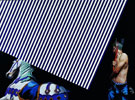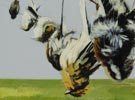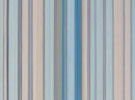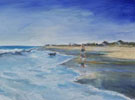The first time when I met Qu Qianmei and also paid my visit to her studio, I was furtively surprised at her creation which deeply stunned me. For quite a long time I have not caught sight of such a captivating masterpiece. How could a frail woman like her endure such a burden? How would there be such a mighty explosive power? How could she bring about so melancholy profound works? How could she render such a bitter tone of desolation and dignified tragic atmosphere? As if having experienced a war or disaster, they are deeply worried, traumatic, catastrophic and nirvana of life. I could not help thinking of those “charred landscapes” of Kiefer which are vast barren nature in gloomy tone. This “sense of scorched earth” is imbued with traces of history and wars, also remains the spiritual shadow left for the German post-war generation by wars. In Qu’ work, I feel a kind of trauma and dull pain from the soul, yet it does not take the usual personal narrative full of womanly grief and its layout is provided with noble tragic consciousness and epic momentum.
It is true that one could not really relate these works of Qu Qianmei with herself. Half an hour ago, she was working here dressed in her overalls. It’s rarely found in the past that there is such a huge contrast between an artist and her works. I could not help tracking down where they are from. Obviously, if not from an “inner requirement”, not inspired by some emotions and spirits, nor undergoing ups and downs to survive, one could not create such profound works. The reason why abstract art has to give up depictions of the intelligible concrete world lies in that its real goal is to guide directly to inner spiritual appeals. It is such a strong desire for spiritual pursuit that constitutes her driving force and explosive power like volcanoes. Therefore, although these works have strict forms of scrutiny, they are not pure forms of game; in spite of their experimental nature of different media and materials, they never fall into the amusement of materials. Qu Qianmei does not perfect her own art from the noumenal sense while her works are provided with both deep emotional characteristics of expressionism and spiritual strength and ideological connotations abstract art should possess.
Compared with her previous works, Qu Qianmei’s series of paintings recently produced in the past two years have experienced a qualitative leap. This leap benefits from both her long-term artistic accumulation abroad (especially her deep preference for Tapies) and her forthright advanced studies at the Central Academy of Fine Arts. However they are not complete enough to facilitate her leaps and bounds in art, what has really opened her creative gate is her trip to Tibet. As she says, “There, I found where my pure land of soul coverts.” “I could not help unleashing my emotions since I’ve already found my direction.” “Accumulation and fascination of many years has turned into creative passion and hard work, and blended into the red clay on the plateau, integrated into images in my dreams, broken in its all fury…”
In the early years of 1980s, there was still no room for abstract art in China and it was also officially regarded as “bourgeois decadent art”. Even in the past 20 years, abstract art remains its position of fringe in China. Neither is it officially favored nor is thought highly in the market. The most pathetic thing about it is that it is believed to have nothing to do with the contemporary by academics. But there are still so many artists who are interested in it have been persistent and finally develop it into a hot issue in recent years. This has been relevant to the involvements of many outstanding abstract artists who are returnees such as Su Xiaobai, Jiang Dahai, Zhang Guolong, Tang Chenghua, etc. Now “splendid debut” of Qu Qianmei who has been to France for more than 20 years adds another mainstay for Chinese abstract art.
The earlier group of Chinese abstract artists has grown maturely mostly overseas as well as in Hong Kong and Taiwan such as Zhu Yuanzhi, Chen Yinpi, Zhao Chunxiang, Zeng Youhe and Wei Letang who have settled in U.S.A ; Zhao Wuji and Zhu Dequn who are in France; Xiao Qin in Italy. If coupled with artists who went overseas from Taiwan and Hong Kong, we could have a larger number of abstract artists on the list who push their frontier overseas. It is this “overseas legion” among abstract art that constitutes the “chapter outside” in the history of modern art in China. Although living overseas and adopting western tools and materials to create, these Chinese abstract artists maintain their strong blood contact with Chinese traditions in their artistic creation. Today, a new generation of abstract artists has grown up and they will invent a new history and step forward on the basis of former achievements.
Jia Fangzhou




